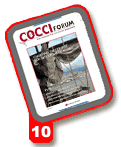
Other articles
in this issue
Without a Doubt
Latest data confirm that vaccination yields equal or better protection than in-feed antibiotics.
Recently released data show that
performance in broilers vaccinated
for coccidiosis continues
to equal or surpass that of broilers on
a traditional program with in-feed
anticoccidials.
“The latest results corroborate
some of the findings from last year’s
study and also show that producers are
achieving great performance with
Coccivac-B, regardless of bird size,”
says Dr. Linnea Newman, a veterinary
consultant for Schering-Plough Animal
Health Corporation.
“Producers can confidently vaccinate
their flocks and expect both protection
against coccidiosis and excellent
performance,” she says.
‘Apples to apples’
This is the second year that performance
data has been available from an
industry reporting service in the United
States. In 2003, the results in broilers
vaccinated with Coccivac-B were good,
but birds of all weights were lumped
together, leaving it difficult to tell with
exact certainty how birds in different
weight classes were faring, Newman
explains.
The latest data, from 2004, separates
birds into different weight classes and
provides an “apples-to-apples” comparison. “It shows that, without a
doubt, vaccinated birds did as well as
or better than birds receiving in-feed
anticoccidials,” she says.
In the study, birds vaccinated with
Coccivac-B were compared to birds of
similar weight at different complexes
that were on a traditional anticoccidial
program. Both groups were compared
weekly during the same time, from
week 29 (July 18) to week 48
(December 5).
 Figure 1. 42-day mortality
(complexes 5.2 – 6.0 lbs). |
 Figure 2. Live bird weight
(complexes 5.2 – 6.0 lbs). |
 Figure 3. 42-day mortality
(complexes >6.0 lbs). |
 Figure 4. Days to 5.0 lbs
(complexes >6.0 lbs). |
 Figure 5. Days to 5.0 lbs
(before & after transition to Coccivac-B). |
All together, there were 27 complexes - 9 vaccinated, and 18 using a
traditional anticoccidial. Processingweight ranged from 5.2 to 6.2 pounds.
Key results:
- Mean bird weight of the vaccinated
birds was 5.79 lbs, compared to 5.59
lbs for the anticoccidial group.
- Vaccinated birds demonstrated better
caloric conversion and better livability
(Figure 1) in this weight class.
- Vaccinated birds had faster weight
gain, averaging 2 days faster to 5 lbs
compared to the anticoccidial group
(Figure 2).
- The performance index also was better
for vaccinated flocks, which had a
0.2 to 0.4 cent advantage compared
to birds in the other group.
In the 36 complexes processing
birds 6 lbs or more - 15 vaccinated
and 21 using traditional anticoccidials
- the results were also excellent for
coccidiosis-vaccinated birds:
- Mean bird weight was 7.23 lbs in
vaccinated birds compared to 7.22
lbs in the anticoccidial group.
- The performance index and feed
conversion in vaccinated birds closely
matched that of the anticoccidial
group.
- Vaccinated birds demonstrated an
advantage in livability (Figure 3)
and rate of gain (Figure 4) that
translated into a slight performance
index advantage.
“We expect long term performance
with Coccivac-B to improve further
with annual vaccination, since it
renews sensitivity of the house coccidial
population to anticoccidials,”
Newman says.
“Our actual overall 2004 performance
numbers have improved compared
to 2003, echoing the industry
performance improvements,” she says.
“As the industry improves its performance
year after year, Coccivac-B performance
remains in step. Coccivac-B
provides a highly competitive alternative
to in-feed anticoccidials with the
added advantage of enhancing Eimeria
sensitivity to all control methods.”









 © 2000 - 2021. Global Ag MediaNinguna parte de este sitio puede ser reproducida sin previa autorización.
© 2000 - 2021. Global Ag MediaNinguna parte de este sitio puede ser reproducida sin previa autorización.